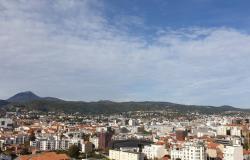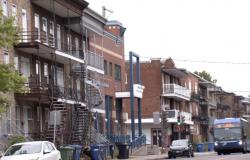An expert stroller, the writer André Carpentier walks the streets of Montreal with no other objective than to “respond to what is.” Report of a walk in Villeray in the company of the man whose work draws an ode to the poetic virtues of slowing down.
Posted at 1:01 a.m.
Updated at 7:00 a.m.
“Look at the lintels, how well decorated they are,” André Carpentier whispers to me as we slowly walk down rue Drolet, after having found ourselves at the rue Jarry Est branch of Café Larue & Fils, in the Villeray district.
A few moments ago, the hubbub of the city was still tickling our ears, then we turn right onto rue Gounod, time to reach avenue Henri-Julien, one of the favorites of the writer, a child of Rosemont.
“You walk in here and then after 25 steps, there’s a silence that settles. We spontaneously want to lower our voice,” rejoices the man who, unlike many of the pedestrians he meets, rarely relies on his smartphone, except to identify a species of tree, thanks to the app Branch.
PHOTO CATHERINE LEFEBVRE, SPECIAL COLLABORATION
André Carpentier
Novelist and short story writer, André Carpentier is also among the pioneers in Quebec of what is called geopoetics, a practice whose followers are reconnecting with the lost art of strolling. Objective: (re)learn to see what, in our surroundings, usually escapes us. Re-enchant your relationship with space and the city.
He published in 2023 Meet the street (Leméac), last title of his Quartet of the Montreal flâneurAfter Lanes, working days (2005), Coffee extracts (2010) and Park moments (2016).
Thanks to a quilt of tender sketches, furtive, yet meaningful impressions, and reflections imbued with humility, these books weave a human-level portrait of a Montreal where everyone tries to carve out their place in the sun. .
“When I gave the first class in my traveling writers seminar,” says the retired UQAM literature professor, “I asked the students: what is in front of your house? A house ? All right. What is the balcony of the house like? Wooden, PVC, wrought iron? And there, I had just lost half the class. »

PHOTO CATHERINE LEFEBVRE, SPECIAL COLLABORATION
At the corner of rue Gounod and avenue Henri-Julien
Our guide bends down to tie his shoelace, but his shoelace is not untied. “That’s an old trick, just to listen, without showing it,” explains this “discreet snoop” who will discreetly spy on the conversation of two ladies on the other side of the street. “It’s the time of year when people get together after winter. And for me, that is high poetry. »
The unfamiliarity of the familiar
The urban stroller, in his own city, can therefore become a kind of traveler, as long as he opens his eyes enough. “When you are in a distant country, there can be something familiar in the unfamiliar,” emphasizes André Carpentier, “because a mother with her child is always a mother with her child. But there is also something unfamiliar in our familiar, because we do not look at this familiar, we do not interpret it, we do not think about it. »
What exactly is he looking for during his unrouted walks? In search of nothing specific, other than “to respond to what is”, we read in Meet the street, a formula borrowed from Paul Valéry. This is because the stroll of the geopoetician is an alert stroll, but not an inquisitive one. A stroll ready to catch on the fly those moments during which there is “meaning beyond”.
What interests me is the human phenomenon.
André Carpentier
Because if we are what we eat, we are also where we live. One day, André Carpentier goes to Verdun in the hope of trying to find his cousins’ childhood home, where he was going to play.
“The original house had been replaced by an architect’s house,” he remembers. And all of a sudden I see the owner come out and he was like his house. ” We laugh. “The house clashed with the neighborhood and the gentleman clashed with the neighborhood. »

PHOTO CATHERINE LEFEBVRE, SPECIAL COLLABORATION
In the greenery of Villeray
From parish to metro
André Carpentier would like to show me a lush tree that he remembers and which stands behind “a house that looks like nothing”, in an alley, between avenue Henri-Julien and rue Drolet, at near the Jean-Talon market. “I’m talking to you about a tree so big that we wouldn’t be able to go around it with our four arms. » A tree whose magnificence will indeed justify the detour and in front of which the minutes will expand.
But first, a short break in rue Molière, time to observe former textile factories, which have become condo buildings, one of the many manifestations of a neighborhood in transformation.

PHOTO CATHERINE LEFEBVRE, SPECIAL COLLABORATION
Alley scene
We are here in what was once called the Sainte-Cécile parish. “Before, when people asked you where you lived, you gave the name of your parish,” the author recalls. This is what structured the social organization. Now you give the name of the nearest metro. »
We greet each other as we approach Beaubien station and each continue our way, feeling, in the words of André Carpentier, “protected from all annoyance by the azure sky”.

Meet the street
André Carpentier
Leméac
344 pages











